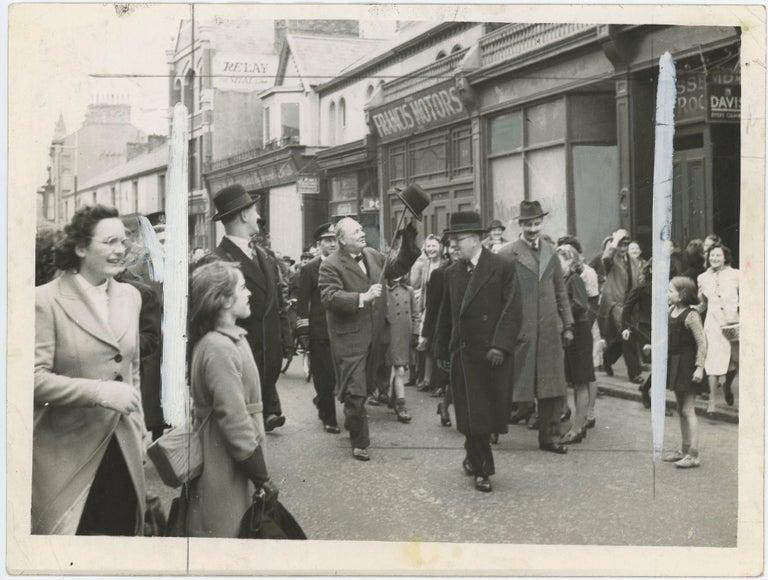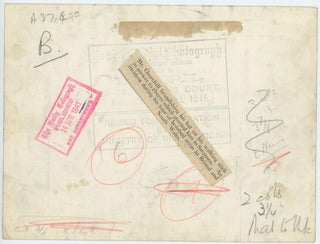An original wartime press photograph of Prime Minister Winston S. Churchill followed by cheering crowds as he surveys bomb damage on 12 April 1941, during the last weeks of The Blitz
London: Copyright British Official Photography supplied by Bippa, published by The Daily Telegraph, 14 April 1941. Photograph. This original press photograph captures Prime Minister Winston S. Churchill during The Blitz on 12 April 1941 waving his hat on the end of his walking stick as he tours fresh bomb-damage in Bristol. This photograph is an official government photo “passed for publication by the Ministry of Information”. The gelatin silver print on matte photo paper measures 6 x 8 inches (15.2 x 20.3 cm). Condition is very good minus. The paper is crisp with only light wear along the edges mostly confined to the margins, original crop marks, and some creasing to the corners. This photo belonged to The Daily Telegraph’s working archives and features their Art Department’s original, hand applied retouching to the buildings as well as the figures’ faces and clothing. The verso bears the copyright stamp of “British Official Photography | Crown Copyright Reserved”, a published stamp from The Daily Telegraph dated 14 APR 1941, handwritten printing notations, and a clipping of the caption as it was published in the newspaper, reading “Mr. Churchill brandishing his hat on his walking stick in answer to cheers which greeted him in Swansea. An incident during his tour of bombed areas in Bristol and South Wales.” This photograph is housed in a removable, archival mylar sleeve within a rigid, crimson cloth folder.
When Churchill became Prime Minister, the war for Britain was not so much a struggle for victory as a struggle to survive. Churchill’s first year in office saw, among other near-calamities, the Battle of the Atlantic, the fall of France, evacuation at Dunkirk, and the Battle of Britain. Hitler intended the relentless aerial bombardment of British cities by the Luftwaffe during The Blitz as the preparatory effort to an invasion of England. Throughout the war, Churchill often visited bombed sites. In this instance, on the night of 11 April Churchill “travelled to Bristol with Ambassador Winant and Robert Menzies, who were to receive honorary degrees from Churchill, the University’s Chancellor… That night Churchill, family and guests slept in a special train just outside the city. While they slept, German bombers struck at Bristol docks. Woken by the sirens and the bombardment, they watched and listened to the distant raid.”
The next day, Churchill “drove for an hour through the ruined city… Next to the University, a building was still in flames. ‘That you should gather in this way,’ Churchill told his University audience, ‘is a mark of fortitude and phlegm…’ Mary Churchill later recalled the scene: ‘It was quite extraordinary. People kept on arriving late with grime on their faces half washed off. They had their ceremonial robes on, over their fire fighting clothes which were still wet.’ That afternoon, Churchill again inspected the ruins.” (Gilbert, Vol. VI, pp.1058-9)
Lord Ismay later recalled of the day “At one of the rest centres at which you called, there was a poor old woman who had lost all her belongings sobbing her heart out. But as you entered, she took her handkerchief from her eyes and waved it madly shouting ‘Hooray, hooray.’” (Letter of 28 November 1946) “As Churchill’s train pulled out of Bristol station… Averell Harriman noticed that tears filled the Prime Minister’s eyes, and he picked up a newspaper to hid his face from those who were with him...” (Harriman and Abel, Special Envoy to Churchill and Stalin, pp. 29-30)
During the first half of the twentieth century, photojournalism fundamentally changing the way the public interacted with current events. Newspapers assembled expansive archives, including physical copies of photographs like this one, their versos typically marked with ink stamps and notes providing provenance and captions. Newspaper art departments would often take brush, paint, pencil, and marker to the surface of photographs themselves to edit them before publication. Today these photographs exist as repositories of historical memory, technological artifacts, and often striking pieces of vernacular art. Item #005206
Price: $350.00


